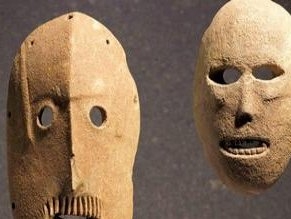|
World Jewish News

World’s oldest masks
|
World’s oldest masks united for first time at the Israel Museum
11.03.2014, Culture With Purim around the corner, the Israel Museum brings together for the first time a rare group of 9,000-year-old stone masks, the oldest known to date, in a new exhibition starting today. Culminating nearly a decade of research, “Face to Face: The Oldest Masks in the World” showcases 12 extraordinary Neolithic masks, all originating in the same region in the ancient Land of Israel.
Oiginally they are all from the same region, found within only about 30 km. from each other in the Judean Hills and nearby in the Judean Desert. It is the first time that the group will be shown together, in their birthplace, and also the first time that the majority of them will be on public view, as they are usually part of private collections. The Israel Museum has held in its collections two Neolithic stone masks so far.
“This is an amazing collection, because the masks represent the first attempt of man to fashion with his hands other physical material,” said James Snyder, director of the Israel Museum, at a preview.
Indeed, the large eye-holes and gaping mouths of the limestone masks create the expression of a human skull.
Debby Hershman, the Museum’s Curator of Prehistoric Cultures, added: “The faces show the moment of transition between life and afterlife.
It is not yet what we today would call religion but it is the first glimmer of existential reflection.” Hershman, who is an archaeologist and anthropologist herself, did over 10 years of research on the 12 masks.
Hershman further explained: “Our interpretation is that the masks represent the skulls of the ones who passed away. They are symbols of the ancestors.”
The experts assume that they are all male and that the biggest one with a strong patina and a massive forehead is symbolizing the spirit of the chief of an ancient tribe, and that it has been used in social ceremonies and in rites of healing and magic.
The archaeologists explored the masks’ geographical origins, and made use of the computerized archaeology laboratory at the Hebrew University of Jerusalem to conduct 3-D analyses that shed light on their comparative features and functions.
“Luckily the masks were made of stone, otherwise they [wouldn’t be] left for us,” Hershman said.
And even though visitors can’t wear the 9000-year-old masks for Purim, they might get inspired by their ancient spirit.
By EVA LINDNER
JPost
|
|
